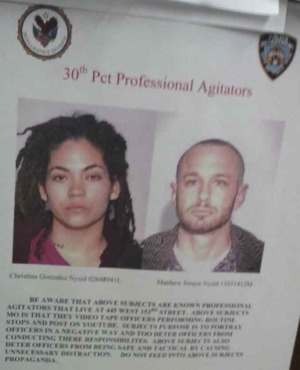Activists Targeted, Defamed by NYPD - Internal Flyer Found
/ From [Alternet] Two West Harlem residents, Christina Gonzalez, 25, and Matthew Swaye, 35, ran into a surprise when they showed up for a community meeting at their local NYPD precinct last week. There, on the wall of the 30th Precinct, were their mug shots—only they weren’t wanted for any crime.
From [Alternet] Two West Harlem residents, Christina Gonzalez, 25, and Matthew Swaye, 35, ran into a surprise when they showed up for a community meeting at their local NYPD precinct last week. There, on the wall of the 30th Precinct, were their mug shots—only they weren’t wanted for any crime.
Christina Gonzalez and Matthew Swaye are police reform activists who regularly film police interactions in their neighborhood, especially to record the NYPD’s controversial Stop and Frisk policy. Although filming police is completely legal, the poster (which was full of misspellings, I might add), advised officers to "be aware" that these "professional agitators" not only film police "performing routine stops," but also" post the videos on YouTube.
"Subjects purpose is to portray officers in a negative way and to [sic] deter officers from conducting their [sic] responsibilities." the warning from Sergeant Nicholson reads. "Do not feed into above subjects’ propaganda."
Gonzalez says it is the NYPD spreading propaganda and that the poster is an obvious tactic to criminalize, intimidate and target her. Since Gonzalez became involved with Occupy and the Stop-and-Frisk movement this fall, police have given her plenty of reasons to look over her shoulder, including calling her out by name and address, erecting a watchtower on her corner and aggressively arresting her sister in front of Gonzalez.
Of course, this is not the first time the NYPD or other police departments have targeted activists. The New York police have a history of infiltrating and intimidating activists, particularly during the Black Panther movement of the 1960s and 1970s.
For activists like Gonzalez, Stop-and-Frisk, a racial profiling tactic, is not only a violation of one’s constitutional rights, it is also part of the NYPD’s larger apparatus of racial oppression. Police stop more than 700,00 people per year, almost 90 percent of whom are young Black and Latino men. The best defense against the illegal searches, which occur during about 50% of stops, has proven to be video, and the ACLU recently launched an app to combat and document unconstitutional stops. But while the movement relies on cameras to expose Stop-and-Frisk, the NYPD targets filmers like Gonzalez with the same type of surveillance and repression police have used against activists in the past.
Gonzalez, who grew up in Far Rockaway, Queens, and graduated magnum cum laude from John Jay College of Criminal Justice last year, has long been familiar with the NYPD—though rarely appreciative of their services. A few years ago, she was a victim of intimate partner violence, and the NYPD routinely refused to help her.
“They blamed me for my own abuse,” Gonzalez said. “The police were supposed to protect me.” Her former partner is currently incarcerated for assaulting his latest girlfriend.
Gonzalez says police are familiar with her and her activism, and that as the movement to reform Stop-and-Frisk grows, so, too, does the police reaction. Gonzalez said that, the more she filmed, demonstrated, and was arrested, the more police noticed her, often calling her by name and making comments like, “we remember you,” or, “be careful walking home; it’s a long walk to 153rd Street."
“That’s when I said, ‘Okay, they know where we live.’ That was kind of scary, especially to say in front of my little sister.”
In February, Gonzalez learned the NYPD were watching her YouTube page, where she posted videos of police harassment, such as the time officers taunted Gonzalez by telling her that her dreadlocked hair smells. Shortly after she posted the video, two officers called her by name over to their police car.











































































































































































































































































